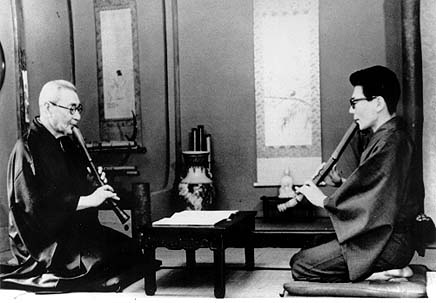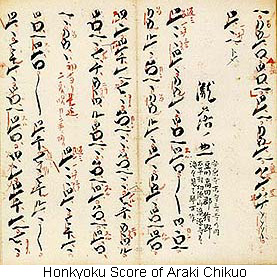Shakuhachi Master - John Singer
The History of the Nezasa Ha Kinpu Ryu
Introduction
This article is a compilation and translation of material concerning the 36 Kinko Ryu Honkyoku shakuhachi pieces, including 3 more that were later added into the Honkyoku repertoire of the Kinko Ryu (school).

Yamaguchi Shiro and Yamaguchi Goro
Photo courtesy of Yamaguchi Goro
The Honkyoku: Background Information
The Honkyoku, sometimes in this country called "Zen Music", derives
from the ancient tradition of the Komuso (straw-hat wandering priests)
 who used the shakuhachi as a tool in their various religious practices
(shugyo). These mendicant monks were well known for wandering and playing
the Shakuhachi and their history can be traced back to Japan's Muromachi
period (1338-1573 A.D.). The Komuso later formed the Fuke-Sect, a sub-sect
of the Rinzai-Sect of Zen Buddhism. At one point in time, the Fuke-Sect
consisted of well over 100 temples throughout Japan. Sometime during the
18th century, a high ranking Komuso named Kinko Kurosawa was commissioned
by the Ichigetsu-Ji Fuke Temple to travel to the various other temples
to collect Honkyoku pieces. Thus, Kinko spent 3 years on the road and
a repertoire of 36 pieces were collected and revised by him. These 36
pieces remain essentially intact to this day. Thus the term "Kinko Ryu
Honkyoku" refers to those specific Honkyoku pieces which were collected
and revised by Kinko Kurosawa.
who used the shakuhachi as a tool in their various religious practices
(shugyo). These mendicant monks were well known for wandering and playing
the Shakuhachi and their history can be traced back to Japan's Muromachi
period (1338-1573 A.D.). The Komuso later formed the Fuke-Sect, a sub-sect
of the Rinzai-Sect of Zen Buddhism. At one point in time, the Fuke-Sect
consisted of well over 100 temples throughout Japan. Sometime during the
18th century, a high ranking Komuso named Kinko Kurosawa was commissioned
by the Ichigetsu-Ji Fuke Temple to travel to the various other temples
to collect Honkyoku pieces. Thus, Kinko spent 3 years on the road and
a repertoire of 36 pieces were collected and revised by him. These 36
pieces remain essentially intact to this day. Thus the term "Kinko Ryu
Honkyoku" refers to those specific Honkyoku pieces which were collected
and revised by Kinko Kurosawa.
In this article, I have added information on 3 more Honkyoku pieces as these were later added into the Kinko Ryu Honkyoku repertoire.
Acknowledgements
I have taken, put together, and translated (with the help of my wife Chika) historical and musical information from a number of sources. The first is the information on each honkyoku piece contained in the book attached to the Kinko Ryu Grand Master Yamaguchi Goro's eleven record set of the 36 Honkyoku pieces. My second source is the Masters thesis written by Kinko Ryu Grand Master Araki Kodo V called, "Kinko Ryu Shakuhachi Honkyoku". My third source is the information contained within the complete Honkyoku record set by the Kinko Ryu Grand Master Aoki Reibo. And lastly, I used some information gathered from my own direct experiences in Japan. At times I have quoted directly from my secondary sources for the sake of convenience and accuracy. However, in the event that errors are found to have been made, it is my hope that my colleagues in the shakuhachi and Japanese music world will give me the appropriate feedback and helpful comments to make any necessary corrections.
I would like to give special thanks to Araki Kodo Sensei for assisting me in making specific corrections in this article.
The Kinko Ryu Honkyoku (Listed in Order)
- HIFUMI HACHIGAESHI NO SHIRABE
- KOTOBUKI NO SHIRABE
- TAKI OTOSHI NO KYOKU
- AKITA SUGAGAKI
- KORO SUGAGAKI

- KYUSHU REIBO
- SHIZU NO KYOKU
- KYO REIBO
- MUKAIJI REIBO
- a. KOKU REIBO
b. KOKU REIBO (IKKAN RYU)
- BANSHIKI CHO
- SHIN KYOREI
- KIN SAN KYOREI
- YOSHIYA REIBO
- YUGURE NO KYOKU
- SAKAI JISHI
- UCHIKAE KYOREI
- IGUSA REIBO
- IZU REIBO
- REIBO NAGASHI
- SOKAKU REIBO
- SANYA SUGAGAKI
- SHIMOTSUKE KYOREI
- MEGURO JISHI
- GINRYU KOKU
- SAYAMA SUGAGAKI
- SAGARIHA NO KYOKU
- NAMIMA REIBO
- SHIKA NO TONEH
- HOSHOSU
- AKEBONO NO SHIRABE
- AKEBONO SUGAGAKI
- ASHI NO SHIRABE
- KOTOJI NO KYOKU
- KINUTA SUGOMORI
- TSUKI NO KYOKU
Additional Honkyoku Adopted by the Kinko Ryu
-
A. KUMOI JISHI
B. AZUMA NO KYOKU
C. SUGAGAKI


Copyright 2001 John Singer. All rights reserved.